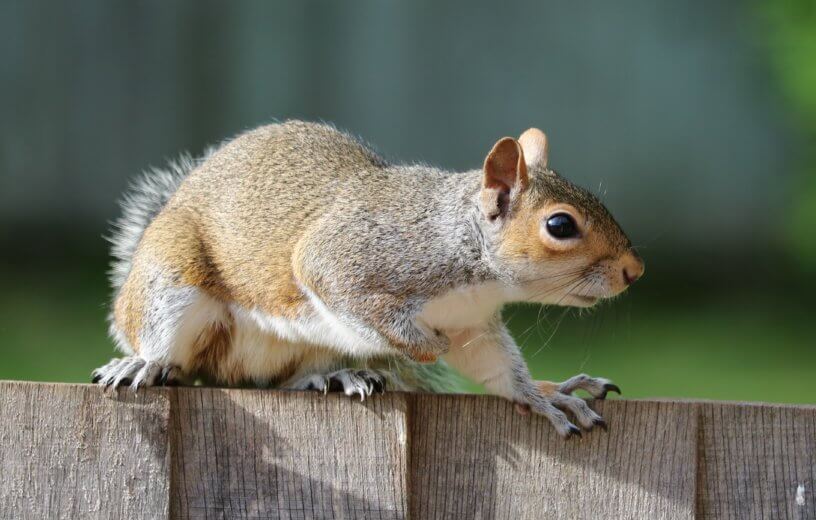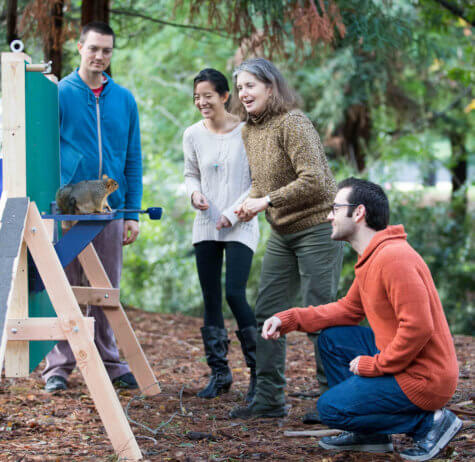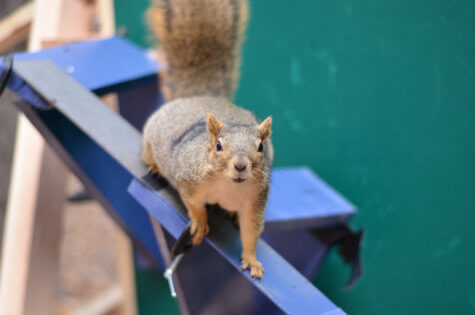
Squirrels are helping scientists develop more agile smart robots
AUGUST 6, 2021
BERKELEY, Calif. — Squirrels – the acrobats of the animal kingdom – are helping scientists develop more agile smart robots. Engineers from the University of California-Berkeley say they’ve gotten to the bottom of the split-second thinking these bushy-tailed rodents display.
These lightning quick reflexes enable them to leap and land on the sturdiest wall or the flimsiest branch. The breakthrough will likely lead to advances in artificial intelligence in the coming years.
Researchers say nimble machines could search for survivors in collapsed buildings or rapidly access landslides and other disaster zones. In the study, the team enticed free roaming squirrels with peanuts as high-speed cameras captured their skillful maneuvers.

(Left to right) UC Berkeley researchers Nate Hunt, Judy Jinn, Lucia Jacobs and Aaron Teixeira.
“As a model organism to understand the biological limits of balance and agility, I would argue that squirrels are second to none,” says former UC Berkeley doctoral student Nathaniel Hunt, now an assistant professor of biomechanics at the University of Nebraska, in a university release.
“If we try to understand how squirrels do this, then we may discover general principles of high performance locomotion in the canopy and other complex terrains that apply to the movements of other animals and robots.”
“As a model organism to understand the biological limits of balance and agility, I would argue that squirrels are second to none,” says former UC Berkeley doctoral student Nathaniel Hunt, now an assistant professor of biomechanics at the University of Nebraska, in a university release.
“If we try to understand how squirrels do this, then we may discover general principles of high performance locomotion in the canopy and other complex terrains that apply to the movements of other animals and robots.”
What keeps squirrels from falling?
The team changed the flexibility, the length of the gap squirrels had to clear, and the position of the landing perch during their experiments with the animals.
“When they leap across a gap, they decide where to take off based on a tradeoff between branch flexibility and the size of the gap they must leap,” Hunt explains. “And when they encounter a branch with novel mechanical properties, they learn to adjust their launching mechanics in just a few jumps. This behavioral flexibility that adapts to the mechanics and geometry of leaping and landing structures is important to accurately leaping across a gap to land on a small target.”
Study authors carried out a series of experiments in a grove of eucalyptus trees in the university’s botanical garden. Fox squirrels that roam the campus grounds grabbed and swung with astonishing creativity, running less and jumping further on weaker branches. It took only five tries to work out the best landing spot on the most flexible rods without faltering.
To reach the highest perch, the squirrels used their “parkour” skills to bounce off a wall to adjust speed and get to the food. Interestingly, the study finds a squirrel’s pliability was six times more critical than distance in deciding whether to jump.
Squirrels know their sharp claws will save them, the researchers explain. Their natural abilities are foolproof that none actually fell, despite wobbly leaps and overshooting or undershooting their landings.
“They’re not always going to have their best performance — they just have to be good enough,” Dr. Hunt continues.
“They have redundancy. So, if they miss, they don’t hit their center of mass right on the landing perch, they’re amazing at being able to grab onto it. They’ll swing underneath, they’ll swing over the top. They just don’t fall.”
Applying squirrel physics to new technology
Exploration and innovation come into play as squirrels search for the most reliable strategy as they move around.

Fox squirrel, apparatus, and experimenters on UC Berkeley campus.
“If they leap into the air with too much speed or too little speed, they can use a variety of landing maneuvers to compensate,” the Nebraska researcher says.
“If they jump too far, they roll forward around the branch. If they jump short, they will land with their front legs and swing underneath before pulling themselves up on top of the perch. This combination of adaptive planning behaviors, learning control and reactive stabilizing maneuvers helps them move quickly through the branches without falling.”
“If they leap into the air with too much speed or too little speed, they can use a variety of landing maneuvers to compensate,” the Nebraska researcher says.
“If they jump too far, they roll forward around the branch. If they jump short, they will land with their front legs and swing underneath before pulling themselves up on top of the perch. This combination of adaptive planning behaviors, learning control and reactive stabilizing maneuvers helps them move quickly through the branches without falling.”
During tricky jumps, squirrels would re-orient their bodies to push off a vertical surface to adjust speed and ensure a better landing. The best comparison for humans is when people participate in parkour, a sport where people leap, vault, or swing to quickly traverse obstacles (like city buildings) without the use of any equipment.
“I see this as the next frontier: How are the decisions of movement shaped by our body? This is made far more challenging, because you also must assess your environment,” says UC Berkeley biologist Robert Full.
“That’s an important fundamental biology question. Fortunately, now we can understand how to embody control and explain innovation by creating physical models, like the most agile smart robots ever built.”
The study appears in the journal Science.
No comments:
Post a Comment